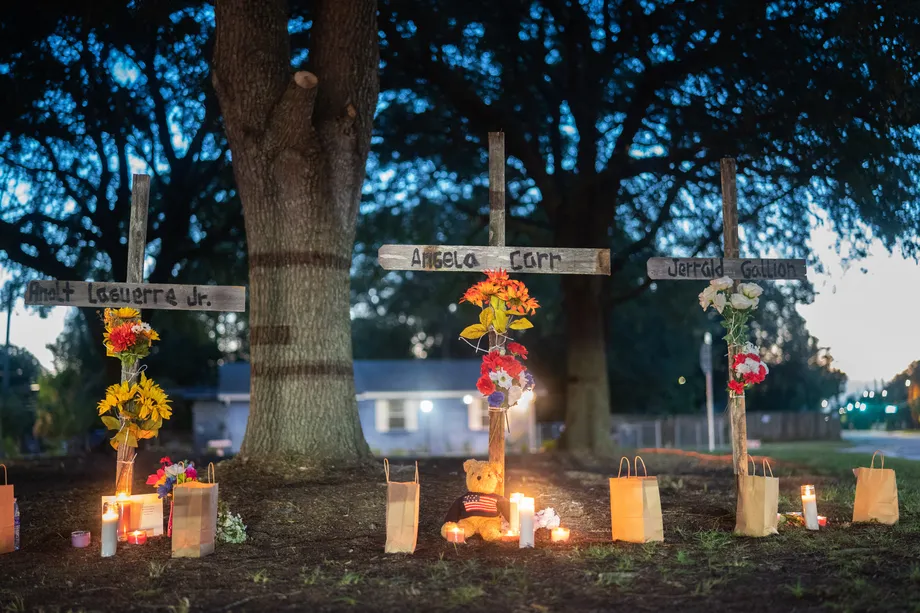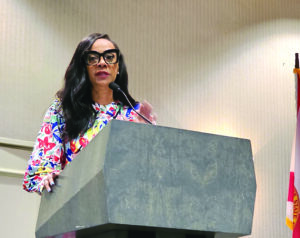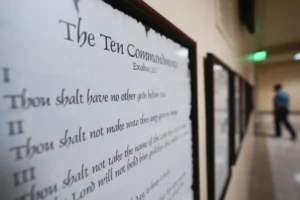White supremacy is at the heart of the Jacksonville shooting
4 min read
By: Li Zhou is a politics reporter at Vox, where she covers Congress and elections. Previously, she was a tech policy reporter at Politico and an editorial fellow at the Atlantic.
The shooting adds to a litany of anti-Black attacks in recent years.
On Saturday, a white gunman in Jacksonville, Florida, killed three Black people at a Dollar General store in what authorities have described as an anti-Black hate crime. The shooter wrote a racist manifesto ahead of the attack, used racist slurs in his writings, and drew swastikas on his firearm.
“This shooting was racially motivated, and he hated Black people,” Jacksonville Sheriff T.K. Waters said at a press conference. The three victims, two of whom were shoppers and one of whom was a Dollar General employee, are Angela Michelle Carr, 52; Jerrald Gallion, 29; and Anolt Joseph “AJ” Laguerre Jr, 19. The shooter died of an apparent suicide following the rampage.
The shooting is the latest in a string of racist attacks in which perpetrators have targeted Black people in recent years, including a mass shooting at the Tops supermarket in Buffalo that killed 10 people in 2022 and a mass shooting at a historically Black church in Charleston that killed nine people in 2015. Prior to his attack at Dollar General, the gunman was flagged by a security guard near the campus of Edward Waters University in Jacksonville, a historically Black institution. After the guard approached him, the shooter drove away.
FBI data on hate crimes also shows that there’s been an uptick in hate crimes directed at Black Americans and other racial groups in recent years. Though the FBI’s data is incomplete and therefore somewhat unreliable, it remains one of the most comprehensive sources of hate crime data available. It shows that in 2020, hate crimes toward Black Americans were up 49 percent, compared to 2019, and that in 2021 the latest period for which data is available hate crimes toward Black Americans were up another 14 percent compared to 2020.
Such attacks have come as Republican leaders and GOP-aligned media personalities have amplified racist ideas like the “Great Replacement Theory,” a white supremacist conspiracy theory that white people are being oppressed and pushed out by minority groups. Some experts have also theorized that this increase has been driven in part by blowback to the Black Lives Matter protests in 2020, which criticized police killings of Black people and racism more broadly.
“Those protests brought out a lot of anger about African Americans. A lot of support, but also a lot of anger,” Jeannine Bell, an Indiana University professor who specializes in the study of hate crimes, told the New York Times in 2022. “Black victimization was in the news. And if it’s anything that angers white supremacists, it’s seeing African Americans being seen sympathetically.”
A large proportion of hate crimes have targeted Black Americans
FBI data has long shown that Black Americans have been a major target of hate crimes. The bureau’s data doesn’t capture the full scope of the issue, because there’s significant underreporting both from police and people experiencing hate crimes, but it’s shown a consistent trend.
As Time previously reported, Black Americans have been the most frequent victims of hate crimes since the FBI began documenting these attacks in 1991. According to a Marshall Project analysis of the FBI data from 2020 to 2021, nearly one-third of hate incidents included attacks on Black Americans, the largest category of such crimes. Overall, the 2021 FBI report shows that attacks based on race or ethnicity comprised about 65 percent of the hate crimes that were reported.
Such racist violence has deep roots: Race-based violence was a central feature of slavery in America. And as the population of free Black Americans grew, attacks like lynchings became commonly used by white supremacist groups, including the Ku Klux Klan, to kill and harm Black Americans, as well as to generally stoke fear. According to data from the NAACP, there were at least 4,743 lynchings between 1882 and 1968.
Since then, racist violence has continued in other forms, including disproportionate police killings of Black Americans and civilian attacks like those against 25-year old Ahmaud Arbery, who was killed by three white men in 2020 while running in Georgia. Recent trends have fueled additional violence, and according to a March report from the Anti-Defamation League, the distribution of white supremacist propaganda and the holding of related events is at an “all-time high.” As Vox’s Fabiola Cineas has previously explained, the current environment has led the US Department of Homeland Security to call extremists motivated by race and ethnicity “the most persistent and lethal threat in the Homeland.”
Several groups in addition to Black Americans have seen increases in the number of hate crimes targeting them, per the 2021 FBI report, including Asian Americans, who saw a 167 percent jump, and LGBTQ people, who saw a 70 percent jump. These two groups experienced some of the biggest percentage increases. The wave of anti-Asian hate in recent years is likely due to incendiary Republican rhetoric about the origins of Covid-19 in China, a bipartisan focus on economic and political competition with China, and lingering, racist questions about Asian Americans’ loyalty to the US. Meanwhile, a string of new bills going after LGBTQ people including legislation targeting drag performers and trans youth is likely contributing to anti-LGTBQ backlash and violence.
The Department of Justice has said it is investigating the Jacksonville shooting as a hate crime and as an act of violent extremism.
“One of the Justice Department’s first priorities upon its founding in 1870 was to bring to justice white supremacists who used violence to terrorize Black Americans,” Attorney General Merrick Garland said in a statement. “That remains our urgent charge today.”








